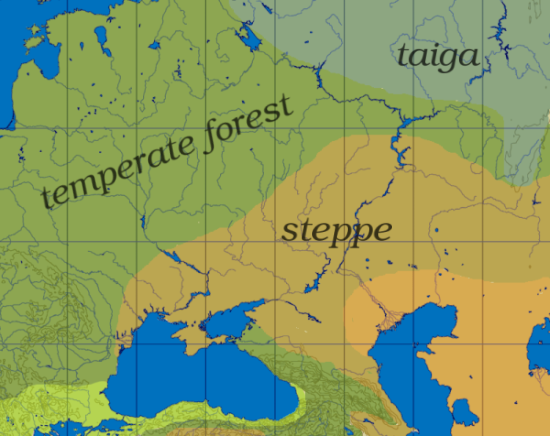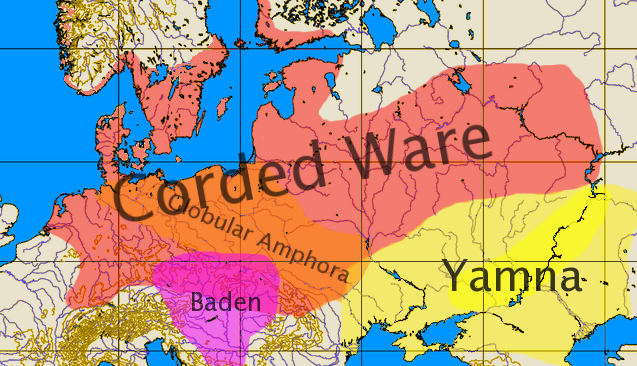







The Proto-Indo-Europeans were the speakers of the Proto-Indo-European language (PIE), a reconstructed prehistoric language of Eurasia. Knowledge of them comes chiefly from the linguistic reconstruction, along with material evidence from archaeology and archaeogenetics.
According to some archaeologists, PIE speakers cannot be assumed to have been a single, identifiable people or tribe, but were a group of loosely related populations ancestral to the later, still partially prehistoric, Bronze Age Indo-Europeans.
This view is held especially by those archaeologists who posit an original homeland of vast extent and immense time depth. However, this view is not shared by linguists, as proto-languages generally occupy small geographical areas over a very limited time span, and are generally spoken by close-knit communities such as a single small tribe.
The Proto-Indo-Europeans likely lived during the late Neolithic, or roughly the 4th millennium BC. Mainstream scholarship places them in the forest-steppe zone immediately to the north of the western end of the Pontic-Caspian steppe in Eastern Europe. Some archaeologists would extend the time depth of PIE to the middle Neolithic (5500 to 4500 BCE) or even the early Neolithic (7500 to 5500 BC), and suggest alternative location hypotheses.
The Maykop culture (also spelled Maikop), ca. 3700-3000 BC, was a major Bronze Age archaeological culture in the Western Caucasus region of Southern Russia. It extends along the area from the Taman Peninsula at the Kerch Strait to near the modern border of Dagestan and southwards to the Kura River. The culture takes its name from a royal burial found in Maykop in the Kuban River valley.
In the south it borders the approximately contemporaneous Kura-Araxes culture (3500-2200 BC), which extends into eastern Anatolia and apparently influenced it. To the north is the Yamna culture, including the Novotitorovka culture (3300-2700), which it overlaps in territorial extent. It is contemporaneous with the late Uruk period in Mesopotamia.
The Kuban River is navigable for much of its length and provides an easy water-passage via the Sea of Azov to the territory of the Yamna culture, along the Don and Donets River systems. The Maykop culture was thus well-situated to exploit the trading possibilities with the central Ukraine area.
After the discovery of the Leyla-Tepe culture in the 1980s it was suggested that elements of the Maykop culture migrated to the south-eastern slopes of the Caucasus in modern Azerbaijan. New data revealed the similarity of artifacts from the Maykop culture with those found recently in the course of excavations of the ancient city of Tell Khazneh in northern Syria, the construction of which dates back to 4000 BC.
The work unearthed the remains of hundreds of tombs and ancient settlements from the end of the Copper Age (Chalcolithic or Eneolithic Age, the first half of the 4th millennium BC) right up to the Middle Ages inclusive. These sites were found mainly in what is today Western Azerbaijan, along the middle reaches of the Kur River. From ancient times the favourable geography of the region attracted tribes engaged in agriculture and cattle-breeding.
These finds are evidence of the high development of crafts such as pottery, bone working, stone working, metal working and weaving of the settled agricultural and cattle-breeding tribes. The Soyugbulag barrows, the first barrows of the Copper Age in the whole South Caucasus, are especially important remains of the Leylatepe culture.
Apart from Khojakhan, all the aforementioned Copper Age sites concern the Leylatepe archaeological culture or people. The Leyla Tepe people emerged in the first half of the 4th millennium BC as the result of the migration of the northern Ubaid tribes from Mesopotamia to the South Caucasus, especially Azerbaijan. The Leylatepe people were named after the site of the same name in Agdam District which was excavated in the 1980s.
After inhabiting the Northern Caucasus in the second half of the 4th millennium BC, the Leylatepe people became part of the Maykop people. Therefore, the research into the remains of the Leylatepe culture is of great importance in the study of the cultural, economic and ethnic links of the Caucasus and the Middle East.
The new high dating of the Maikop culture essentially signifies that there is no chronological hiatus separating the collapse of the Chalcolithic Balkan centre of metallurgical production and the appearance of Maikop and the sudden explosion of Caucasian metallurgical production and use of arsenical copper/bronzes.
More than forty calibrated radiocarbon dates on Maikop and related materials now support this high chronology; and the revised dating for the Maikop culture means that the earliest kurgans occur in the northwestern and southern Caucasus and precede by several centuries those of the Pit-Grave (Yamnaya) cultures of the western Eurasian steppes (cf. Chernykh and Orlovskaya 2004a and b).
The calibrated radiocarbon dates suggest that the Maikop ‘culture’ seems to have had a formative influence on steppe kurgan burial rituals and what now appears to be the later development of the Pit-Grave (Yamnaya) culture on the Eurasian steppes (Chernykh and Orlovskaya 2004a: 97).
In other words, sometime around the middle of the 4th millennium BCE or slightly subsequent to the initial appearance of the Maikop culture of the NW Caucasus, settlements containing proto-Kura-Araxes or early Kura-Araxes materials first appear across a broad area that stretches from the Caspian littoral of the northeastern Caucasus in the north to the Erzurum region of the Anatolian Plateau in the west.
For simplicity’s sake these roughly simultaneous developments across this broad area will be considered as representing the beginnings of the Early Bronze Age or the initial stages of development of the KuraAraxes/Early Transcaucasian culture.
The archaeological record seems to document a movement of peoples north to south across a very extensive part of the Ancient Near East from the end of the 4th to the first half of the 3rd millennium BCE. Although migrations are notoriously difficult to document on archaeological evidence, these materials constitute one of the best examples of prehistoric movements of peoples available for the Early Bronze Age.
The inhumation practices of the Maikop culture were characteristically Indo-European, typically in a pit, sometimes stone-lined, topped with a kurgan (or tumulus). Stone cairns replace kurgans in later interments. The Maykop kurgan was extremely rich in gold and silver artifacts; unusual for the time. The Maykop culture is believed to be one of the first to use the wheel.
The Maykop nobility enjoyed horse riding and probably used horses in warfare. It should be noted that the Maykop people lived sedentary lives, and horses formed a very low percentage of their livestock, which mostly consisted of pigs and cattle.
Archaeologists have discovered a unique form of bronze cheek-pieces, which consists of a bronze rod with a twisted loop in the middle and a thread through her nodes that connects with bridle, halter strap and headband. Notches and bumps on the edges of the cheek-pieces were, apparently, to fix nose and under-lip belts.
The culture has been described as, at the very least, a “kurganized” local culture with strong ethnic and linguistic links to the descendants of the Proto-Indo-Europeans. It has been linked to the Lower Mikhaylovka group and Kemi Oba culture, and more distantly, to the Globular Amphora and Corded Ware cultures, if only in an economic sense.
Gamkrelidze and Ivanov, whose views are somewhat controversial, suggest that the Maykop culture (or its ancestor) may have been a way-station for Indo-Europeans migrating from the South Caucasus and/or eastern Anatolia to a secondary Urheimat on the steppe. This would essentially place the Anatolian stock in Anatolia from the beginning, and at least in this instance, agrees with Colin Renfrew’s Anatolian hypothesis.
Considering that some attempt has been made to unite Indo-European with the Northwest Caucasian languages, an earlier Caucasian pre-Urheimat is not out of the question. However, most linguists and archaeologists consider this hypothesis highly unlikely, and prefer the Eurasian steppes as the genuine IE Urheimat.
In the early 20th century, researchers established the existence of a local Maykop animal style in the found artifacts. This style was seen as the prototype for animal styles of later archaeological cultures: the Maykop animal style is more than a thousand years older than the Scythian, Sarmatian and Celtic animal styles. Attributed to the Maykop culture are petroglyphs which have yet to be deciphered.
The construction of artificial terrace complexes in the mountains is evidence of their sedentary living, high population density, and high levels of agricultural and technical skills. The terraces were built around the fourth millennium BC. They are among the most ancient in the world, but they are little studied. The longevity of the terraces (more than 5000 years) allows us to consider their builders unsurpassed engineers and craftsmen.
By the late third millennium BC, offshoots of the Proto-Indo-Europeans had reached Anatolia (Hittites), the Aegean (Mycenaean Greece), Western Europe (Corded Ware culture), the edges of Central Asia (Yamna culture), and southern Siberia (Afanasevo culture).
A central challenge in ancient DNA research is that for many bones that contain genuine DNA, the great majority of molecules in sequencing libraries are microbial. Thus, it has been impractical to carry out whole genome analyses of substantial numbers of ancient individuals.
We report a strategy for in-solution capture of ancient DNA from approximately 390,000 single nucleotide polymorphism (SNP) targets, adapting a method of Fu et al. PNAS 2013 who enriched a 40,000 year old DNA sample for the entire chromosome 21. Of the SNPs targets, the vast majority overlap the Affymetrix Human Origins array, allowing us to compare the ancient samples to a database of more than 2,700 present-day humans from 250 groups.
We applied the SNP capture as well as mitochondrial genome enrichment to a series of 65 bones dating to between 3,000-9,000 years ago from the Samara district of Russia in the far east of Europe, a region that has been suggested to be part of the Proto-Indo-European homeland.
We successfully extracted nuclear data from 10-90% of targeted SNPs for more than 40 of the samples, and for all of these samples also obtained complete mitochondrial genomes. We report three key findings:
- Samples from the Samara region possess Ancient North Eurasian (ANE) admixture related to a recently published 24,000 year old Upper Paleolithic Siberian genome. This contrasts with both European agriculturalists and with European hunter-gatherers from Luxembourg and Iberia who had little such ancestry (Lazaridis et al. arXiv.org 2013). This suggests that European steppe groups may be implicated in the dispersal of ANE ancestry across Europe where it is currently pervasive.
- The mtDNA composition of the steppe population is primarily West Eurasian, in contrast with northwest Russian samples of this period (Der Sarkissian et al. PLoS Genetics 2013) where an East Eurasian presence is evident.
- Samara experienced major population turnovers over time: early samples (>6000 years) belong primarily to mtDNA haplogroups U4 and U5, typical of European hunter-gatherers but later ones include haplogroups W, H, T, I, K, J.
We report modeling analyses showing how the steppe samples may relate to ancient and present-day DNA samples from the rest of Europe, the Caucasus, and South Asia, thereby clarifying the relationship of steppe groups to the genetic, archaeological and linguistic transformations of the late Neolithic and Bronze ages.
Ancient human genomes suggest (more than) three ancestral populations for present-day Europeans
The story of R1a: the academics flounder on
Another look at the Lazaridis et al. ancient genomes preprint
First genome of an Upper Paleolithic human (Mal’ta boy)
Filed under: Uncategorized